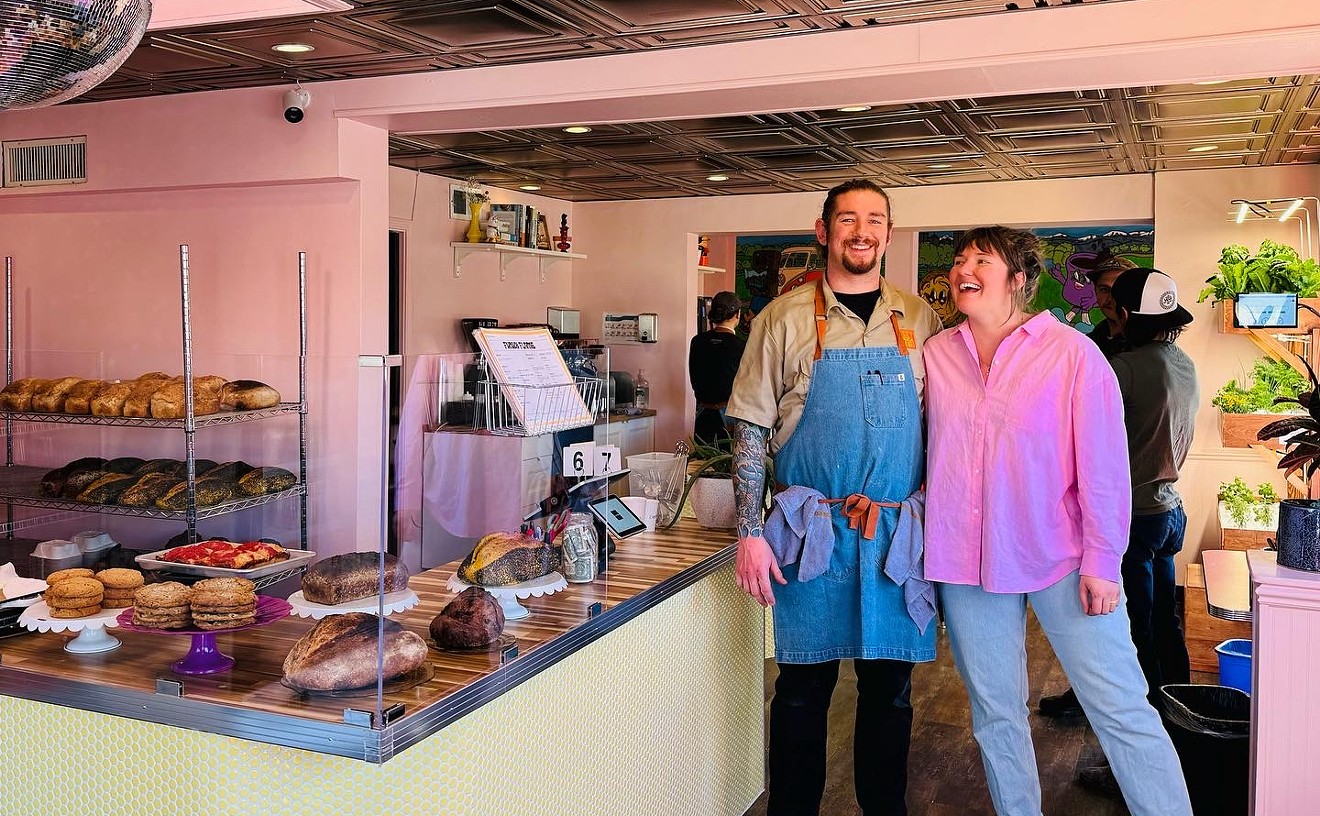Biju’s Little Curry Shop opened in December in a spot overlooking an alley and a short patch of 26th Street barely visible from the trendy stretches of Walnut and Larimer streets heading into RiNo from Ballpark. While opening a restaurant in an obscure location during the holiday season doesn’t seem like a recipe for success, it turns out that owner/chef Biju Thomas has all the recipes he needs to keep scores of customers coming in the door, overflowing onto the patios and even taking bowls of piping-hot curry to tables at Zephyr Brewing Co. next door (as long as they promise to buy a beer). Those recipes come from Thomas’s childhood in the southern Indian region of Kerala, honed over the years during his career as a professional chef and cookbook author specializing in feeding endurance athletes.
Thomas spent a year or so in Denver as a toddler but otherwise lived in India until he was ten; his family moved permanently to the Highland neighborhood in 1980. A combination of the approach to food in Kerala and his passion for competitive cycling in high school led him to create a style of cuisine that he felt would work here, especially for professional athletes.
“We were literally in the jungles of South India,” he says of his early years. “There was no refrigeration, so nobody made food for more than a day or a day and a half.” The area had no electricity for stoves, much less microwave ovens and convenience food. Even something as simple as hot tea or coffee required planning: “You had to have wood to start a fire to boil water.”
In Denver, he continued to eat freshly prepared food with his family while noticing that the people who needed it most — cyclists and other endurance athletes — were relying on packaged foods from a new and growing market sector of high-performance snacks, drinks and bars. Although he enjoyed cycling in high school, he was soon looking for another calling. “I wanted to be good, but I sucked,” he remembers.
“Eventually I saw a need to cook for athletes.” Tired of seeing racers eating overpriced and over-engineered packaged foods for energy and nutrition, Thomas dedicated himself to giving them something better and began cooking for his teammates.
“I wanted to get people away from the idea that corporations have the answer to your dietary needs,” he explains, adding that cyclists and other athletes “can’t feel like shit after they eat. Every single meal counts, every ingredient counts.” So during an extended endurance event, when the body requires nothing more than hydration and readily available fuel, Thomas recommends a peanut butter sandwich and plenty of water instead of pricey and dense nutrition bars, which give riders and runners a false sense of satiation and can lead to dehydration.
Even while he was riding in high school, Thomas had started working in restaurants — starting as a dishwasher at age fifteen. By the 1990s, he was getting noticed as a team chef, eventually working with cycling pros Andy Hampsten, Davis Phinney, Jonathan Vaughters and the Slipstream cycling team.
He was cooking for a cycling dinner party hosted by Vaughters when he met Allen Lim, who was so impressed with Thomas’s food that the doctor contacted him afterward with the idea for a cookbook. The result was The Feed Zone Cookbook, which Thomas hoped would introduce athletes to delicious and fast recipes. He’d noticed that most cookbooks geared toward nutrition were boring and overly complicated, so he packed The Feed Zone full of photos (one for every recipe) and kept the steps simple. “Most of them are four or five ingredients and two steps,” he explains. “I cooked all 150 dishes in my shitty apartment in Lafayette in three days.”
Thomas went on to write Feed Zone Portables; he continues to partner with Lim at Skratch Labs, a company that makes all-natural performance foods and drinks, and has cooked for Lance Armstrong and actor Patrick Dempsey, who competes in endurance auto racing. “In the cycling world, no one else has my job,” he notes.
But by the early 2000s, Thomas was also cooking in restaurant kitchens and consulting on menus. He did a brief stint at Boulder’s Bombay Bistro and worked as chef at Swimclub32, a now-defunct West Highland restaurant that was ahead of its time, he says: “We were growing herbs on the rooftop, and [owner] Grant Gingerich was bringing tomatoes from his own garden. We’d go pick apples off the neighbors’ trees to make pies.” When Gingerich turned the location into El Camino, Thomas remembers, the turnover took about three days; he painted the front wall pink and wrote the Mexican-themed menu.
In the back of his mind, though, he knew he wanted to introduce Denver to the kind of food he’d eaten growing up. Instead of the stereotypical Indian buffet fare loaded with butter and sugar, these dishes were based on spice mixes, fresh chiles and good-quality meats and vegetables. “This is the way I cook at home for friends,” he explains, “with everything in a bowl so that every bite is different.”
And so he decided to open Biju. But there were challenges to having his own spot. “The biggest thing for me is how to take the food that’s in my head and that I want to serve people and dial it in,” he explains. “I’ve only done South Indian for fun and for friends.” Getting into a rhythm was also difficult, because of the manually intensive nature of the food — not to mention the almost-immediate audience Biju’s attracted. Thomas usually starts his days at 6 a.m., prepping spice blends and sauces. Those spice blends are mixed in five-gallon buckets using ingredients sourced from Thomas’s contacts in Kerala. He’s working on a plan to contract with a company in India to mix the spices in larger quantities, though, since his goal has always been to operate multiple locations of Biju’s and also sell the blends by the jar.
Some of his recipes call for a starting spice blend that’s used for roasting or braising meats as well as a separate finishing blend. All of the hot sauces are made from scratch, sometimes several times daily. With only a six-burner stove and a tiny back kitchen for prep work and dishwashing, those spice blends are the only things that are made more than a day in advance. Business has grown so quickly — word of mouth from cyclists has spread Biju’s reputation across the country — that Thomas is looking into leasing commissary space nearby “to at least get the knife work out of here. It’s amazing that nobody has gotten stabbed yet.”
Lunch has been particularly successful for Biju’s, but dinner is quickly catching up: The kitchen is now putting out about 1,500 meals a week, and Thomas is already scouting for a new location, possibly in the Stanley Marketplace planned for Aurora, near Stapleton.
But difficulty finding cooks could limit expansion. Thomas estimates that even seasoned veterans have a three-month learning curve to master his unique food — and with so many new restaurants opening in Denver over the past couple of years, talent is spread thin. “I can pay cooks better than average,” he notes, “but for hourly, I can’t compete with tipped staff.” He also doesn’t want to endanger quality by cutting corners. “We’re doing what we started out wanting to do,” he notes.
And people want what he wants to do: At a recent off-site event at the new Friday Night Bazaar in River North put on by the Big Wonderful group, Thomas had a line at his stand from 6 p.m. straight through to midnight, when the event ended.
Biju’s is open every day but Sunday, giving Thomas time to spend with his girlfriend. But even then, he admits, “we plan Sunday dinners, including dessert. We talk about it a week ahead of time.” Lately they’ve been talking about fried chicken, one of his favorites, along with tacos. “We have an electric deep-fryer and we spent all day trying different styles,” he says. Their favorite chicken ended up being a version soaked in buttermilk with a light flour dusting and a coating of panko breadcrumbs.
An English major in college, Thomas once wanted to be a professional writer, and he continues to publish food and health articles in Men’s Journal, Outside and other fitness periodicals. Between those articles and the Feed Zone cookbooks, he’s often recognized more for his writing than his cooking, he says. But if you see him at Biju’s, he’ll definitely be cooking. If he doesn’t look up to say “Hi,” it’s only because in the blur of jockeying pots around the stove and chopping through chiles, he wants to be sure he doesn’t stab anyone.
[
{
"name": "Air - MediumRectangle - Inline Content - Mobile Display Size",
"component": "12017618",
"insertPoint": "2",
"requiredCountToDisplay": "2"
},{
"name": "Editor Picks",
"component": "17242653",
"insertPoint": "4",
"requiredCountToDisplay": "1"
},{
"name": "Inline Links",
"component": "18838239",
"insertPoint": "8th",
"startingPoint": 8,
"requiredCountToDisplay": "7",
"maxInsertions": 25
},{
"name": "Air - MediumRectangle - Combo - Inline Content",
"component": "17261320",
"insertPoint": "8th",
"startingPoint": 8,
"requiredCountToDisplay": "7",
"maxInsertions": 25
},{
"name": "Inline Links",
"component": "18838239",
"insertPoint": "8th",
"startingPoint": 12,
"requiredCountToDisplay": "11",
"maxInsertions": 25
},{
"name": "Air - Leaderboard Tower - Combo - Inline Content",
"component": "17261321",
"insertPoint": "8th",
"startingPoint": 12,
"requiredCountToDisplay": "11",
"maxInsertions": 25
}
]











